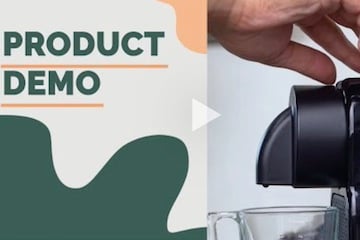Ecommerce SMBs Need Faceless Videos

So-called “faceless videos” use voiceovers, animations, and images to tell a story, educate, or entertain. In the ecommerce context, these relatively easy-to-make videos promote items and build trust.
Video is an excellent way to showcase products and convert shoppers. Enterprise retailers often place videos on ecommerce pages, social media, and ads.
The only drawback is production. Compared to a blog post or a text-based search ad, videos are expensive to produce and require a much higher skill level. Thus some small and mid-sized ecommerce businesses avoid videos altogether.
AI-enabled Faceless Video
Online merchants produced “faceless” videos before the term became a buzzword. Tools such as Animoto have facilitated such videos for 15 years, as in the recent example below.
These tools make creating a video much easier, but the video-production bar was still above some merchant’s reach. Fortunately, generative artificial intelligence has made faceless video production achievable for nearly every ecommerce business.
Consider a faceless video workflow.
- Idea generation. Generative AI models — ChatGPT, Gemini, Claude, and Grok — can help create faceless video ideas.
- Scripting and storyboarding. AI tools such as Jasper and Copy.ai feature script writing, although many other AI models can compose video scripts.
- Gathering visuals. For this step, an ecommerce business might use product images in combination with AI-generated pictures or video from tools such as Midjourney, Grok, or Pika.
- Recording the voiceover. This might be an actual recording or AI-generated audio from ElevenLabs, Murf.ai, and others.
- Video editing. Use AI, humans, or a combination.
Generative AI can help throughout the process. Multiple AI-powered platforms perform almost all these steps based on a prompt or two.
Why Faceless Videos?
AI makes creating faceless ecommerce videos nearly as easy as asking ChatGPT to rewrite some Google Ads copy. But why should online merchants use such videos at all?
The answer is more sales — in five ways.
Video advertising. Most common digital advertising platforms, from Meta’s Facebook and Instagram to Snapchat and Google Ads, support video formats. These platforms report that video in ads boosts performance. A 2023 Meta analysis showed a 35% improvement in clicks for vertical Reels ads containing video with audio.
Showcase products. Videos showing and describing a product and its features can appear directly on its detailed web page. This common practice boosts conversations. With an automated workflow employing Zapier (or similar) and generative AI tools described above, a merchant could generate a faceless product video for every item in a store.
Customer service. The same AI-enabled workflow for products could also generate customer service videos addressing, say, return policies or frequently asked questions.
Content marketing. Several AI tools can convert a blog post or product description into a faceless video, which merchants can embed on the item’s page or distribute via YouTube.
Social media marketing. Finally, videos drive modern social media marketing, and faceless versions — in full or excerpted into vertical shorts — can work on just about every platform, from YouTube to Meta.
Faceless or Humans?
Faceless videos are not perfect.
Some users report that faceless versions do not build trust as well as a human speaker. A person saying, “Hi, I am Bob Smith, and I want to tell you why I love this product,” carries more emotional clout than a voiceover.
Plus, some social media platforms — TikTok, in particular — favor videos with humans such as influencers talking directly into the camera.
Nonetheless, faceless videos can help ecommerce shops improve advertising performance, showcase products, provide customer information, and produce engaging content.
And thanks to ever-improving AI, this type of video is relatively easy to produce.




